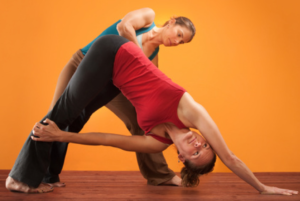Ready to join the millions of people practicing yoga? If you’re a yoga beginner, these 9 tips will help you get a good start on your own yoga practice. The ancient art of yoga has helpful guidelines to follow for a safe and healthy yoga practice. The yoga beginners’ journey starts with mastering breathing to help you learn to listen to your body. Here are 9 helpful tips for yoga beginners as you embark on the amazing journey of beginning your own yoga practice.
Click here to see the prenatal yoga schedule
1. Find a Good Yoga Teacher:
Yoga is an ancient art that has been passed down from master to apprentice in India, each student perfecting their skill and passing it on to the next. In the west, though, group classes are taught. One on one instruction doesn’t happen often. Using videos is good if there are no other options, but it is always a better idea to learn this art of yoga from a living, breathing, teacher, in person, instead of a book or video. The teacher’s presence and expertise are more beneficial for you as a yoga beginner. Find a teacher at Yoga Alliance
Gentle Hatha: Free Yourself – Online yoga class with Jackie Casal Mahrou
2. Respect Your Body’s Inner Wisdom and Limitations:
While practicing Yoga, it is essential to recognize your body’s limits instead of pushing yourself to do something harmful to your body. This concept is known as ‘Ahimsa’; the practice of non-harming. It is essential to consult your teacher and/or a medical professional if you have sustained an injury or are pregnant. It should also be noted that some poses are contraindicated during menstruation, pregnancy, and other special circumstances.
Yoga for Menstruation yoga class with Jackie Casal Mahrou
YogaDownload.com: Prenatal Yoga 1 led by Liza Janda.
3. Breathe:
Learning breath awareness and proper abdominal breathing will benefit you in your yoga practice and in your life in general. The breath is the bridge between developing harmony between your mind and body and is integral to this art of yoga. Learn breathing techniques at Yoga Download:
Guidelines for a Balanced Life: Pranayama yoga class with Les Leventhal
Pranayama Meditation to Ground and Calm the Mind with Maria Garre
Pranayama for Better Sleep Yoga Class with Maria Garre
Beat the Winter Blues Pranayama yoga class with Maria Garre
4. Do Not Compare Yourself to Others:
At this point, a yoga beginner should realize that Yoga is never a competition or a place to compare yourself to others. Observing yourself without judgement or expectations is key to a good yoga practice. Appreciate where you are from day to day. Our bodies change daily. One day you may feel strong and adept. The next day you may see your body has different limitations. Be okay and accepting of your body’s changes and limitations.
5. Eating and Drinking Before Yoga:
It’s advised by Yogi’s, and medical practitioners alike, that eating and drinking an hour before Yoga should be avoided. Digestive issues can make your yoga practice uncomfortable and not as beneficial. Not eating or drinking and hour before your practice can help you avoid some embarrassing gas passing moments too. Sugar intake, caffeine, and alcohol should similarly be avoided before your Yoga class.
6. Practice Frequently:
Yoga can be a long-term commitment. Before venturing into the world of yoga it is important to ask yourself if you are willing to give it a try long enough to feel and see the benefits. Fifteen minutes of Yoga integrated into your daily routine is better than occasional bouts of long sessions of Yoga. Daily practice will reap more benefits, especially if you select some well-chosen postures and poses. But daily practice isn’t realistic for many busy people. If you can only practice once or twice a week, that is better than nothing at all and may be more achievable. Regular practice will make your body feel much more familiar with the process, rather than over-committing, and quitting every other day and starting all over again.
7. Modify Postures for Your Body:
Yoga is not at all about achieving the perfect form or posture on your first try. The pose we currently see our teacher holding may be a long way from what we can achieve for the time being. A good instructor will encourage you to achieve your posture through the use of yoga props such as blocks, belts, etc. to harness your energy and train your body to stretch in correct and safe alignment.
8. Communicate With Your Yoga teacher:
Many yoga teachers will assist a student in their practice. They will support you and help you make adjustments in your poses according to any past injuries you have had. But in order for them to assist you, it is imperative for a student to communicate honestly with their teacher and ask for their assistance. Let your yoga teacher know if you have any injuries, recent surgeries, or physical limitations. A good teacher will be able to come up with an alternative for almost every pose.
9. End Your Yoga Session with ‘Savasana’:
For some, the best part of yoga is the final resting period, Savasana. For others lying still is the most challenging pose of all! It is recommended that you finish your yoga session with the Savasana or ‘the Corpse pose’, which involves lying down on the mat for a good 7-10 minutes in order to relax and renew your body. Do not rush out of it either; roll on your right side and then get up very gently to sit in an upright position. Sit for a minute or two and observe how you feel physically and emotionally. End it with a deep cleansing breath.
Hope these tips give our readers the confidence needed before starting this ancient art of yoga practice.
Author Bio:
This guest post was written by Hassan Khan Yousafzai, he is passionate about Digital marketing. Along with educational background in Software Engineering he is bridging gap between marketing and development department. At Techvando, he has been consulting brands all over Pakistan to gain online traffic and profitable leads. Edited by Liza Janda











